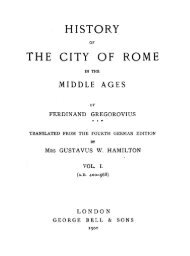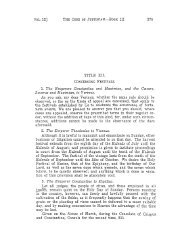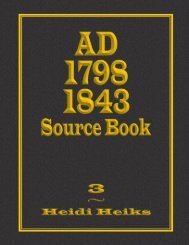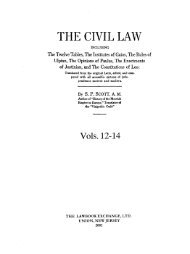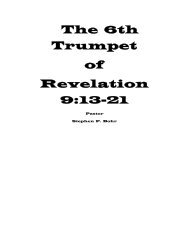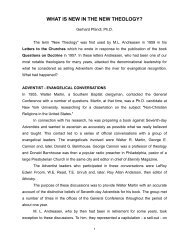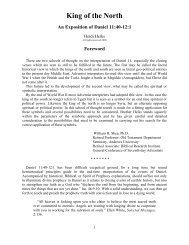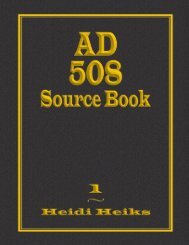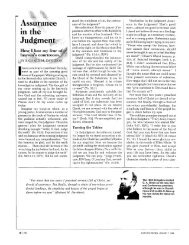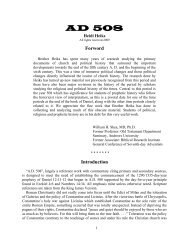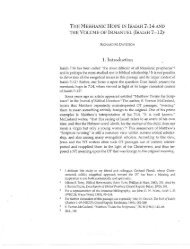How to Interpret Genesis 1
How to Interpret Genesis 1
How to Interpret Genesis 1
- No tags were found...
Create successful ePaper yourself
Turn your PDF publications into a flip-book with our unique Google optimized e-Paper software.
"In the beginning Godcreated the heaven andthe earth. "- <strong>Genesis</strong> 1:1With such beauty, majesty, andsimplicity begins the <strong>Genesis</strong>account of Creation. Yet ananalysis of <strong>Genesis</strong> chapter 1 is not assimple and straightforward as a casualreading of the biblical text may suggest.Modern interpretation of biblicalcosmogony (understanding of origins) in<strong>Genesis</strong> I is extremely complicated,divided between the non-literal and theliteral. We will briefly describe sevensuch interpretations, and evaluate each inthe light of the biblical data.Major interpretations of<strong>Genesis</strong> 1Non-literal interpretationsScholars who hold a non-literalinterpretation of <strong>Genesis</strong> approach theissue in different ways. Some see<strong>Genesis</strong> 1 as mythology!; others view itas poetry2; some consider it as theology3;still others regard it as symbolism. 4Common <strong>to</strong> all these non-literal views isthe assumption that the <strong>Genesis</strong> Creationaccount is not a literal, straightforwardhis<strong>to</strong>rical account of Creation.Literal interpretationsThose who accept a literal readingof the Creation account also differ intheir approaches <strong>to</strong> biblical cosmogonyof <strong>Genesis</strong> 1. We may note three suchviews.Active-gap view. This view is alsoknown as "ruin-res<strong>to</strong>ration" theory.According <strong>to</strong> this view, 5 <strong>Genesis</strong> I: 1describes an originally perfect creationsome unknown time ago (millions orbillions of years ago). Satan was ruler ofthis world, but because of his rebellion(Isaiah 14: 12-17), sin entered theuniverse. God judged the rebellion andreduced it <strong>to</strong> the ruined, chaotic statedescribed in <strong>Genesis</strong> 1:2. Those holdingthis view translate <strong>Genesis</strong> 1:2 as "theearth became without form and void."<strong>Genesis</strong> 1:3 and the following versesthen present an account of a latercreation in which God res<strong>to</strong>red what hadbeen ruined. The geological column isusually fitted in<strong>to</strong> the period of time ofthe first creation (<strong>Genesis</strong> 1: I) and thesucceeding chaos, and not in connectionwith the biblical Flood.Precreation "unfonned-unfilled"view. According <strong>to</strong> this interpretation,the Hebrew terms <strong>to</strong>hu ("unformed") andbohu ("unfilled") in <strong>Genesis</strong> 1:2 describethe "unformed-unfilled" state of theearth. The text refers <strong>to</strong> a state prior <strong>to</strong>the creation spoken of in the Bible. ThisIn theBeg..-....-.·<strong>How</strong> <strong>to</strong>•g:<strong>Interpret</strong><strong>Genesis</strong> 1view has two main variations based ontwo different grammatical analyses.The first variation sees <strong>Genesis</strong> 1: 1as a dependent clause, paralleling theextra-biblical ancient Near Easterncreation accounts. 6 So the translation. proposed: "When God began <strong>to</strong> createthe heaven and earth." Therefore <strong>Genesis</strong>1:2 equals a parenthesis, describing thestate of the earth when God began <strong>to</strong>create ("the earth being ...) and <strong>Genesis</strong>1:3 on describe the actual work ofcreation ("And God said ...").The other major variation takes<strong>Genesis</strong> 1: 1 as an independent clause,and as a summary statement or formalintroduction or title which is thenelaborated in the rest of the narrative. 7byRichard M.DavidsonDialogue 6:3-1994 9 :••
<strong>Genesis</strong> 1:2 is seen as a circumstantialclause cOlUlected with verse 3: "Now theearth was unformed and unfilled .... AndGod said, 'Let there be light.'"In the pre-Creation unformed-unfilledview, supported by either grammaticalanalysis mentioned above, <strong>Genesis</strong> doesnot present an absolute beginning of timefor the cosmos. Creation out of nothing isnot implied, and there is no indication ofGod's existence before matter. Nothing issaid ofthe creation of original matterdescribed in verse 2. The darkness, deep,and water of <strong>Genesis</strong> 1:2 already existedat the beginning ofGod's creativeactivity.We might note in passing anotherpre-Creation view; it takes verse 2 as adependent clause "when ... ," but itdiffers from the first variant in interpretingthe words <strong>to</strong>hu and bohu, and theterms for "darkness" and "deep"-all assignifying "nothingness." So verse I isseen as a summary; verse 2 says thatinitially there was "nothingness," andverse 3 describes the beginning of thecreative process. 8Initial "unformed-unfilled" view. Athird literal interpretation of biblicalcosmogony is the initial "unformedunfilled"view. This is the traditionalview, having the support of the majorityof Jewish and Christian interpretersthrough his<strong>to</strong>ry.9 According <strong>to</strong> thisunderstanding, <strong>Genesis</strong> 1:1 declares thatGod created out of nothing the originalmatter called heaven and earth at thepoint of their absolute beginning. Verse2 clarifies that when the earth was firstcreated it was in a state of <strong>to</strong>hu andbohu-unformed and unfilled. Verse 3and those following then describe thedivine process of forming the unformedand filling the unfilled.This interpretation has two variations.Some see all of verses I and 2 aspart of the first day of the seven-dayCreation week. We may call this the "00gap" interpretation. 'o Others see verses1-2 as a chronological unity separated bya gap in time from the first day ofCreation described in verse 3. This viewis usually termed the "passive gap.""EvaluationSpace does not permit a detailedevaluation of all the pros and cons ofeach view we have summarized, but wewill present the basic con<strong>to</strong>urs of thebiblical data as they pertain <strong>to</strong> thetheories on the origin of matter and lifeand their early existence.Non-literal interpretationsIn considering all the non-literal,nonhis<strong>to</strong>rical interpretations, we musttake in<strong>to</strong> account two significant biblicalfacts:1. The literary genre of<strong>Genesis</strong>chapters 1-11 indicates the intendedliteral nature of the account. 12 The bookof <strong>Genesis</strong> is structured by the word"generations" (Hebrew <strong>to</strong>ledoth) inconnection with each section of the book(13 times). This is a word used elsewherein the setting of genealogies concernedwith the accurate account of time andhis<strong>to</strong>ry. The use of <strong>to</strong>ledoth in <strong>Genesis</strong>2:4 shows that the author intended theaccount ofCreation <strong>to</strong> be just as literal asthe rest of the <strong>Genesis</strong> narratives. 13 Otherbiblical writers take <strong>Genesis</strong> chapters III as literal. In fact, all New Testamentwriters refer affirmatively <strong>to</strong> <strong>Genesis</strong> III as literal his<strong>to</strong>ry.'42. Internal evidence also indicatesthat the Creation account is not <strong>to</strong> betaken symbolically as seven long agesconforming <strong>to</strong> the evolutionary modelassuggested by many both critical andevangelical scholars. The terms "eveningand morning" signify a literal 24-hourday. Elsewhere in Scripture, the wordday with an ordinal number is alwaysliteral. If Creation days are symbolic,Exodus 20:8-11 commemorating a literalSabbath does not make sense. References<strong>to</strong> the function of the sun and moon forsigns, seasons, days, and years (<strong>Genesis</strong>1:14), also indicate literal time, notsymbolic. Therefore, we must concludethat <strong>Genesis</strong> I: 1-2:4a indicates sevenliteral, successive, 24-hour days ofcreation.J5While the non-literal interpretationsmust be rejected in what they deny(namely, the literal, his<strong>to</strong>rical nature ofthe <strong>Genesis</strong> account), nevertheless theyhave an element of truth in what theyaffirm. <strong>Genesis</strong> 1-2 is concerned withmythology-not <strong>to</strong> affirm a mythologicalinterpretation, but as a polemic againstancient Near Eastern mythology.16<strong>Genesis</strong> 1:1-2:4 is very likely structuredin a way similar <strong>to</strong> Hebrew poetry(synthetic parallelism),17 but poetry doesnot negate his<strong>to</strong>ricity (see, for example,Exodus 15, Daniel 7, and some 40percent of the Old Testament, which is inpoetry). Biblical writers often write inpoetry <strong>to</strong> underscore his<strong>to</strong>ricity.<strong>Genesis</strong> 1-2 does present a profoundtheology: doctrines of God, Creation,II<strong>How</strong> CAN TIHNGS.SJ PRHlY AND CLEAN COME OUT OF VIRT'""DENNIS THE MENACE" used by permission of Hank Ketcham and~N~rthAmerica Syndicate.: 10 Dialogue 6:3-1994
humanity, Sabbath, and so on. Buttheology in Scripture is not opposed <strong>to</strong>his<strong>to</strong>ry. In fact, biblical theology isrooted in his<strong>to</strong>ry. Likewise, there is deepsymbolism in <strong>Genesis</strong> 1. For example,the language of the Garden of Eden andthe occupation of Adam and Eve clearlyallude <strong>to</strong> sanctuary imagery and the workof the Levites (see Exodus 25-40).18 Thusthe sanctuary of Eden is a symbol or typeof the heavenly sanctuary. But because itpoints beyond itself does not detractfrom its own literal reality.Gerhard von Rad, a critical scholarwho refuses <strong>to</strong> accept what <strong>Genesis</strong> 1asserts, still honestly confesses, "What issaid here [<strong>Genesis</strong> 1] is intended <strong>to</strong> holdtrue entirely and exactly as it stands."19We therefore affirm the literal,his<strong>to</strong>rical nature of the <strong>Genesis</strong> account.But which literal interpretation iscorrect?Literal interpretationsFirst, we must immediately rejectthe ruin-res<strong>to</strong>ration or active gap theorypurely on grammatical grounds. <strong>Genesis</strong>1:2 clearly contains three noun clausesand the fundamental meaning of nounclauses in Hebrew is something fixed, astate,20 not a sequence or action. According<strong>to</strong> laws of Hebrew grammar, we musttranslate "the earth was unformed andunfilled," not "the earth became unformedand unfilled." Thus Hebrewgrammar leaves no room for the activegap theory.What about the pre-Creationunfonned-unfilled interpretation in whichthe <strong>to</strong>hu-bohu state of <strong>Genesis</strong> 1:2 comesbefore divine creation? Some supportthis by translating verse 1 as a dependentclause. But major lines ofevidence favorthe traditional reading of <strong>Genesis</strong> I: 1 asan independent clause: "In the beginning,God created the heavens andearth." This includes the evidence fromHebrew accent marks, all ancientversions, lexicaUgrammatical, syntacticaland stylistic considerations, and contrastswith ancient Near Eastern s<strong>to</strong>ries. 21 Theweight ofevidence leads me <strong>to</strong> retain thetraditional reading.Others support the pre-Creationunformed-unfilled view by interpreting<strong>Genesis</strong> 1: 1 as a summary of the wholechapter (the actual creation starting onlyin verse 3). But if <strong>Genesis</strong> 1 begins withonly a title or summary, then verse 2contradicts verse 1. God creates the earthDialogue 6:3-1994(verse 1), but the earth preexists creation(verse 2). This interpretation simplycannot explain the reference <strong>to</strong> theexistence of the earth already in verse 2.It breaks the continuity between verse 1and verse 2 in the use of the term earth. 22Therefore I conclude that <strong>Genesis</strong> I: I isnot simply a summary or title of thewhole chapter.Against the suggestion that all thewords in <strong>Genesis</strong> 1:2 simply imply"nothingness," it must be observed thatverses 3 and following do not describethe creation of water, but assume itsprior existence. The word tehol11 "deep,"combined with <strong>to</strong>hu and bohu <strong>to</strong>gether(as in Jeremiah 4:34) do not seem <strong>to</strong>refer <strong>to</strong> nothingness, but rather <strong>to</strong> theealth in an unformed-unfilled statecovered by water.This leads us <strong>to</strong> the initial unJormedunfilledposition. A straightforwardreading of the flow of thought in <strong>Genesis</strong>1:1-3 has led the majority of Christianand Jewish interpreters in the his<strong>to</strong>ry ofinterpretation <strong>to</strong> this position, hence thisis called the traditional view.The natural flow of <strong>Genesis</strong>1..21concur with this view, because Ifind that only this interpretation cohesivelyfollows the natural flow of theseverses, without contradiction or omissionof any element of the text.The flow of thought in <strong>Genesis</strong> 1-2is as follows:a. God is before all creation(verse 1).b. There is an absolute beginningof time with regard <strong>to</strong> this worldand its surrounding heavenlyspheres (verse 1).c. God creates the heavens andearth (verse 1), but they are atfirst different than now, they are"unformed" and "unfilled"(<strong>to</strong>hu and bohu; verse 2).d. On the first day of the sevendayCreation week, God begins<strong>to</strong> form and fill the <strong>to</strong>hu andbohu (verses 3 and following).e. The "forming and filling"creative activity ofGod isaccomplished in six successiveliteral 24-hour days.f. At the end of creation week, theheavens and earth are finallyfinished (<strong>Genesis</strong> 2:1). WhatGod began in verse 1 is nowcompleted.g. God rests on the seventh day,blessing and sanctifying it as amemorial of creation (2: 1-4).The ambiguity of whenThe above points stand clear in theflow of thought of <strong>Genesis</strong> 1-2. <strong>How</strong>ever,there is one crucial aspect in thiscreation process which the text leavesopen and ambiguous: When did theabsolute beginning of the heavens andearth in verse 1 occur? Was it at thecommencement of the seven days ofCreation or sometime before? It ispossible that the "raw materials" of theheavens and earth in their unformedunfilledstate were created long beforethe seven days of creation week. This isthe "passive gap" theory. It is alsopossible that the "raw materials"described in <strong>Genesis</strong> 1: 1, 2 are includedin the first day of the seven-day Creationweek. This is called the "no gap" theory.This ambiguity in the Hebrew texthas implications for interpreting thePrecambrian of the geological column, ifone roughly equates the Precambrianwith the "raw materials" described in<strong>Genesis</strong> 1: 1-2 (of course this equation isdebatable). There is a possibility of ayoung Precambrian, created as part ofthe seven-day Creation week (perhapswith the appearance of old age). There isalso the possibility of the "raw materials"being created at a time of absolutebeginning of this earth and its surroundingheavenly spheres, perhaps millionsor billions of years ago. This initialunformed-unfilled state is described inverse 2. Verses 3 and following thendescribe the process of forming andfilling during the seven-day Creationweek.I conclude that the biblical text of<strong>Genesis</strong> 1 leaves room for either (a) a11 • • ••
young Precambrian (created as part of 3. See, for examples, Conrad Hyers, The 11. See, for example, Harold G. Coffin, Originthe seven days of Creation), or (b) much Meaning ofCrearion: <strong>Genesis</strong> and Modem by Design (Hagers<strong>to</strong>wn, Md.: Review andolder prefossil earth rocks, with a long Science (Atlanta: 10hn Knox, 1984); Davis Herald, 1983), pp. 292-293, who allows forYoung, Creation and rhe Flood: An this possibility. In addition, Clyde L.interval between the creation of theAlrernative ro Flood Geology and TheisticWebster, Jr., "<strong>Genesis</strong> and Time: Whatinanimate "raw materials" on earthEvolurion (Grand Rapids: Baker, 1974), pp.Radiometric Dating Tells Us:' College and86-89. University Dialogue 5:1 (1993), pp. 5-8.described in <strong>Genesis</strong> 1: 1, 2 and the sevendays of Creation week described in4. See, for examples, Derek Kidner, <strong>Genesis</strong>: 12. See Walter Kaiser, "The Literary Form of<strong>Genesis</strong> 1:3 and following. But in either An Inrroduction and Commelltary, Tyndale <strong>Genesis</strong> I-II," in New Perspectives on [hecase, the biblical text calls for a short Old Testament Commentaries (Downers Old Testament, 1. Bar<strong>to</strong>n Payne, ed. (Waco.chronology for life on earth. There is no Grove, II.: Inter-Varsity Press, 1967), pp. Texas: Word, 1970), pp. 48-65.room for any gap of time in the creation 54-58; P.l. Wiseman, Crearion Revealed in 13. Doukhan, pp. 167-220.of life on this earth: it came during the Six Days (London: Marshall. Morgan, and 14. See Matthew 19:4,5; 24:37-39; Mark 10:6;third through the sixth literal, successiveScott, 1948), pp. 33-34; Robert C. Newman Luke 3:38; l7:26, 27; Romans 5:12; Iand Herman 1. Ecke1mann, lr., <strong>Genesis</strong> One Corinthians 6:16; 11:8,9,12: 15:21,22.24-hour days of Creation week. 0and the Origin ofrhe Earth (Downers45; 2 Corinthians I I:3; Ephesians 5:31: IGrove, II.: Inter-Varsity Press, 1977), pp.Timothy 2:13, 14; Hebrews 11:7; I PeterRichard M. Davidson (Ph.D, Andrews 64,65. 3:20; 2 Peter 2:5; 3:4-6; James 3:9; I lohnUniversity) is chairman ofthe Old Testamenr 5. See, for examples, Arthur Custance, 3: 12; lude II, 14; Rev. 14:7.Departmenr ar rhe Sevenrh-day Advelltisr Wirhour Form and Void (Brockville, 15. For further evidence, see TerranceTheological Seminary, Andrews University, Canada: By the Author, 1970); and the Fretheim, "Were the Days of CreationBerrien Springs, Michigan. He is rhe author of Scofield Reference Bible (1917, 1967). Twenty-Four Hours Long? YES," in Theseveral articles and books, including Typology in 6. See, for examples, the following modem <strong>Genesis</strong> Debare: Persistem QuesrionsScripture (Andrews Universiry Press, 1981), Love translations of <strong>Genesis</strong> I:1-3: the New Abour Crearion and rhe Flood. Ronald F.Song for the Sabbath (Review and Herald, 1987), Jewish Version (NIV), the Catholic New Youngblood, ed. (Grand Rapids, Mich.:and In the Footsteps of10shua (Review and American Bible (NAB), and the New Baker, 1990), pp. 12-35.Herald, /995). English Bible; see also E. A. Speiser, 16. See Gerhard Hasel, "The Polemic Nature ofAnchor Bible: <strong>Genesis</strong> (Garden City, N.Y.:the <strong>Genesis</strong> Cosmology," The EvangelicalDoubleday, 1964), pp. 3, 8-13.Quarterly 46 (1974), pp. 81-102; idem,Notes and References 7. See, for examples, Gerhard von Rad, "The Significance of the Cosmology in1. See, for examples, Hermann Gunkel, <strong>Genesis</strong>: A CommentQly, Old Testament <strong>Genesis</strong> I in Relation <strong>to</strong> Ancient NearSchOpjung und Chaos (Gottingen: Library (Philadelphia: Westminster, 1972), Eastern Parallels," Andrews UniversiryVandenhoeck & Ruprecht, 1895): B. S. p. 49; Bruce Waltke, "The Creation Seminary Studies 10 (1972), pp. 1-20.Childs, Myth and Reality in the Old Account in <strong>Genesis</strong> I: 1-3; Part 1II: The 17. See Gordon 1. Wenham, Word BiblicalTesramenr, Studies in Biblical Theology, 27 Initial Chaos Theory and the Precreation Commentary: Gen 1-15 (Waco, Texas:(London: SCM Press, 1962), pp. 31-50. Chaos Theory," Bibliorheca Sacra 132 Word, 1987), pp. 6-7, for a diagram of the2. See, for examples, D. F. Payne, <strong>Genesis</strong> (1975), pp. 225-228. symmetrical matching of the days ofOne Reconsidered (London: Tyndale, 8. See, for example, lacques Doukhan, The Creation.1964); Henri Blocher, In rhe Beginning: <strong>Genesis</strong> Crearion Srory: Irs Lirerary 18. See Gordon Wenham, "SanctuaryThe Opening Chaprers af<strong>Genesis</strong> Srrucrure, Andrews University Seminary Symbolism in the Garden of Eden S<strong>to</strong>ry."(Downers Grove, II.: Inter-Varsity Press, Doc<strong>to</strong>ral Dissertation Series, 5 (Berrien Proceedings ofrhe World Congress of1984), pp. 49,59. Springs, Mich.: Andrews University Press, Jewish Studies 9 (1986), pp. 19-25.1978), pp. 63-73. 19. Von Rad, p. 47.9. For a list of major supporters, and a 20. See Gesenius' Hebrew Grammar, E.detailed defense of this position, seeKautzsch and A. E. Cowley, eds. (Oxford:Gerhard Hasel, "Recent Translations ofClarendon Press, 1910, 1974).454 [par.<strong>Genesis</strong> I: I," The Bible Transla<strong>to</strong>r 22 141 i]; R. L. Reymond, "Does <strong>Genesis</strong> 1:1-(1971), pp. 154-167; and idem, "The 3 Teaeh Creation Out of Nothing?"Meaning ofGen. I:I," Ministry (lanuary Scientific Studies in Special Creation, W.1976), pp. 21 -24. E. Lammerts, ed. (Grand Rapids, Mich.:10. See, for example, Henry Morris, The Baker, 1971), pp. 14-17.Biblical Basis for Modem Science (Grand 21. See Hasel, "Reeent Translations:' and "TheRapids, Mich.: Baker, 1984); and idem, Meaning of Gen. 1:1."The <strong>Genesis</strong> Record (Grand Rapids, Mich.: 22. Gesenius' Hebrew Grammar, p. 455 (par.Baker, 1976), pp. 17-104.142 e), which identifies vs. 2 as acircumstantial clause contemporaneouswith the main clause of vs. I (not of vs. 3).: 12•Dialogue 6:3-1994



